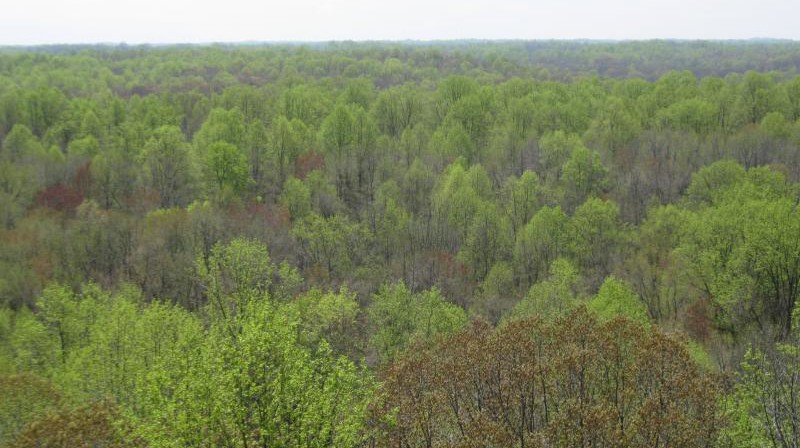by Kristen Minogue

Signs of three temperate forest enemies, left to right: Anthracnose (SERC), insect hole in an acorn (Jonathan Myers), emerald ash borer (Leah Bauer, USDA Forest Service Northern Research Station, Bugwood.org)
Walk through a forest in Maryland or Missouri, and you’ll probably find yourself surrounded by dozens of different tree species. Walk through a tropical forest in Brazil or Malaysia, and you’ll be surrounded by hundreds—in some forests, over 1,000. What’s behind this colossal difference in diversity? Scientists with the Smithsonian-led ForestGEO network came up with one morbid possibility: It may come down to having the right kind of enemy.
Earlier this summer, in a study in Science, researchers from 24 plots in the forest network from five continents pooled their data and detected a strange pattern: There’s a force at work in the tropics helping rare species thrive, a force that is much weaker in the cooler temperate zone.
Call it a clustering effect. The scientific term is “conspecific negative density dependence,” but it boils down to this: If too many trees of the same species grow in the same spot, they become magnets for enemies that slash their populations. In tropical forests, enemies generally knock them down just enough for new species to fill the gaps, without completely wiping out the first species. The result is a kaleidoscope forest with hundreds of species, many quite rare.
It may seem like a counterintuitive idea, that a lethal enemy could help sustain biodiversity. It can work when this thinning process prevents any one species from dominating.
“Just when a population is ready to take over, it catches a cold,” explained Sean McMahon, a co-author and forest ecologist with the Smithsonian Environmental Research Center (SERC). “And so it gets knocked back.”

Canopy of SERC’s ForestGEO plot (Credit: Jess Shue/SERC)
McMahon works in the Smithsonian’s ForestGEO network, or Forest Global Earth Observatory. ForestGEO is a collection of over 65 forest plots around the world, where every five years, scientists map, measure and identify all trees in their plots 1 centimeter or more in diameter. McMahon is in charge of coordinating the forests research plots outside the tropics, in the temperate and boreal zones. With this much material, scientists can explore questions impossible in one forest—questions like why temperate forests are so much less diverse than tropical ones.
In a way, temperate forests always had a disadvantage. McMahon thinks their initial lack of biodiversity could be chalked up largely to one thing: ice ages. “It does matter that in central Pennsylvania there was a mile of ice only 20,000 years ago, and 50 million years ago the Amazon was going strong,” he said.
But the new Science study uncovered another factor that could be holding them back today. In the tropics, the “clustering attracts enemies” effect coincided with huge peaks in biodiversity. In temperate forests, the effect was weaker and tied to lower diversity. The pattern was uncannily clear, yet a number of questions remain—the big one, of course, being why. Why don’t natural enemies enhance biodiversity in temperate forests the way they do in the tropics?
It’s not for lack of enemies. Temperate forests have a wide cast of antagonists, like the anthracnose disease that wiped out many dogwoods in the 1980s and ’90s, or the emerald ash borers and woolly adelgids ravaging eastern U.S. forests today. But while tropical enemies can leave their forests more diverse, temperate enemies are more likely to target a single species and remove it from the forest.

Washington University postdoc Joe LaManna on a field in Montana.
Joe LaManna, a postdoc at Washington University in St. Louis who led the Science study, specializes in uncovering how plant enemies operate. One possibility, he said, is that the tropics attract a different class of enemy—such as a specialized disease rather than a generalist herbivore.
A class of pickier tropical enemies could explain why they don’t wipe their victims off the map, LaManna suggests. If an enemy relies on one or two plant species and kills too many of them, its own population suffers and the attack fizzles out. However, if enemies are less specialized in the temperate zone—like a squirrel or another generalist mammal—they can afford to wipe out a species or two while they devour other things.
“If you have a generalist predator and you have a rare species, then that generalist predator can be subsidized by other prey items, and it can drive that species to extinction,” LaManna said.
McMahon has a second idea: Plants may be able to grow out of their enemies before their populations get exterminated, because larger, older plants are more resistant. “The types of pathogens that can kill you when you’re small don’t kill you when you get bigger, and so it kind of disappears,” he said.
But there could be another reason temperate-zone enemies are more destructive than tropical enemies. This study focused on “natural enemies.” In the temperate zone, many of the most feared enemies aren’t “natural” parts of the ecosystem. They’re invasive. Forest ecologist Jess Parker and his lab recently detected emerald ash borer invading SERC’s ForestGEO plot, where he has worked since 1987.
“The reason we have a problem with it is, it’s an exotic. None of our ashes have had a chance to co-evolve with it,” he said. “And I think probably the same with the balsam woolly adelgid, and the same thing with the chestnut blight and the dogwood anthracnose—all those things came from outside.”
As climate warms, temperate forests may see more non-natural enemies cross over. Perhaps, when it comes to biodiversity, the lesson from the tropics isn’t to love your enemies. Rather—to the extent that you can—choose them wisely.
Learn more:
Is this the long-sought answer to the question of tropical biodiversity?
Invasive ash borer found in Smithsonian Environmental Research Center forests

